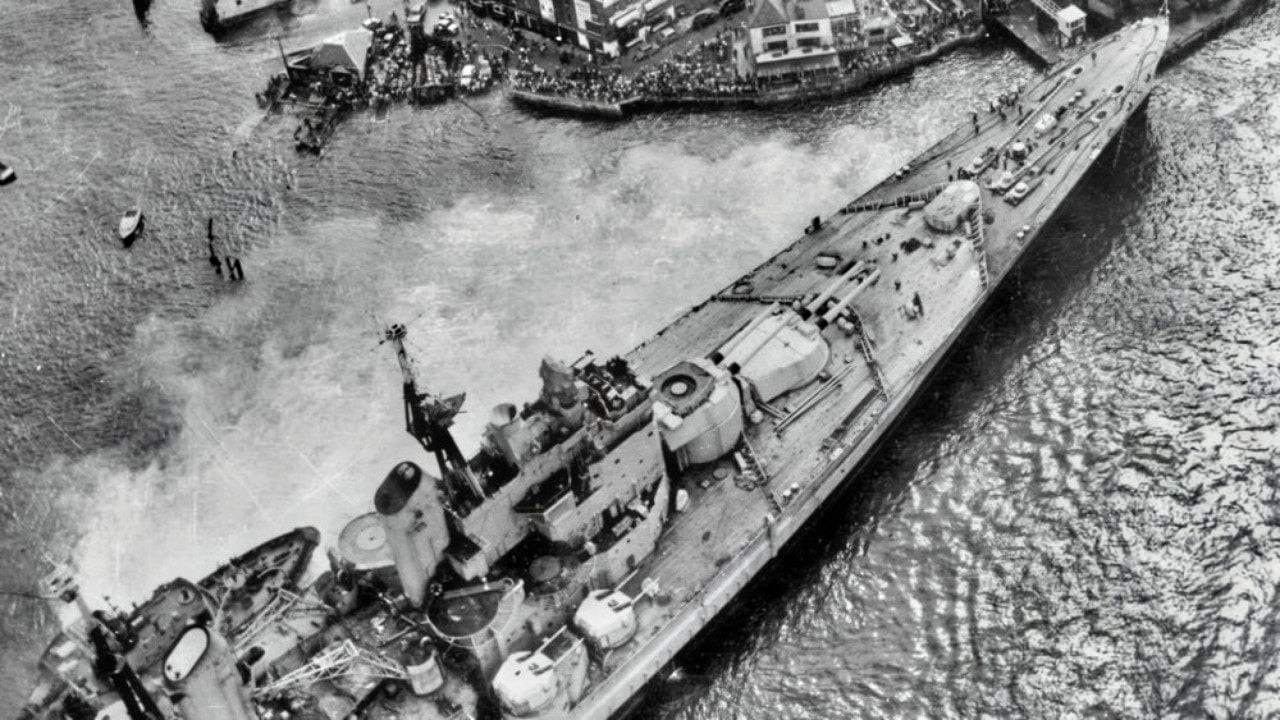The British HMS Vanguard was the last battleship ever built by the Royal Navy and considered the best.
This dreadnought was a powerhouse and the pride of the British fleet after World War Two. The HMS Vanguard was the only battleship of the Vanguard-class.
It was laid down in 1941 and served until 1960. After that retirement, the Royal Navy had no more battleships.
Let’s profile this historic vessel to see why the British looked back on it so fondly.
Some even argue this might be the best battleship ever.
It Was Time to Bear Down on Shipbuilding
In 1941, the British navy struggled due to Germany’s undersea warfare featuring the feared U-boats. It had already lost five large capital ships.
Plus, the Germans and the Japanese were pumping out their own battleships in numbers.
Better Defenses Needed Against the Japanese Air Force
The Vanguard was built to improve on the older King George V-class. The British also learned combat lessons from the King George V-class, which made the Vanguard a formidable vessel.
The HMS Prince of Wales had been destroyed and sunk by the Japanese and after a meeting of the minds of designers and engineers it was determined that the anti-aircraft weapons onboard the Prince of Wales were ineffective against Japanese fighters and bombers.
The Quest to Defeat Enemy Airplanes
So, the workers focused on those outdated systems, and they removed the 20mm anti-aircraft guns and replaced them with 40mm mounts. There were a stunning 73 40mm guns on board the Vanguard.
These armaments were the “best and most sophisticated… ever fitted on a British battleship,” according to military historian R.A. Burt. Vanguard also had sixteen 5.25-inch dual-purpose guns for aircraft or anti-ship duties.
Bombard Them to the Stone Age
And that wasn’t all when outfitting the battleship with extraordinary firepower. The Vanguard had eight 15-inch 42-caliber Mark I guns.
These were taken from old British dreadnoughts later converted into aircraft carriers in the 1930s. “Waste not want not” was the mantra of the British navy during World War Two. The Royal Navy was ever resourceful.
Large Engines Powered the Ships to a Noteworthy Top Speed
The Vanguard was a remarkable 814 long, which eclipsed the King George V battleships by almost 70 feet. The British wanted to include an extra set of 15-inch guns with the added length. The Vanguard displaced more than 45,000 tons. The engines produced 130,000 horsepower with a respectable top speed of 30 knots. Even though it had a large beam, it was able to navigate the Panama Canal.
Not In Time to Serve in the War
There was a problem. These specs required a long shipbuilding period. Even though the Vanguard was laid down in 1941, it wasn’t commissioned until 1946, so it missed World War Two.
The problem was a lack of workers building anti-submarine ships to protect convoys supplying the British army. Unfortunately, the Vanguard was not a priority at the shipyard.
But what a ship. The Royal Navy was able to test the Vanguard at sea trials for a lengthy period since the war was over.
R.A. Burt wrote the armor was so good that it “was one of the best-protected battleships ever built.” Vanguard was the “only British capital ship to have a transom (flat) stern. Her high flared bow and recessed hawse pipes, which allowed her anchors to be flush with her hull, resulted in a magnificent sea boat,” Burt added.
HMS Vanguard: A Battleship with No Mission or Enemy
Unfortunately, the ship was “all dressed up with nowhere to go.” HMS Vanguard had no combat record. This was too bad because it was such a well-built vessel with many modern attributes at the time. The Royal Navy likely wasn’t sure if the battleship had a place in the 1950s when aircraft carriers ruled supreme.
The Cold War was on, and the British military was trying to figure out how it would challenge the Soviet Union’s navy.
The Vanguard was not known for its anti-submarine abilities, and admirals wondered if the Russian torpedoes would be a problem even though it had such heavy armor. It did, however, serve during NATO operations during the Cold War.
By 1955, the Vanguard was outdated and relegated to reserve duty. It was the last battleship of the British navy and stood for a time when capital ships ruled the sea. The Vanguard was used to train new sailors, and they were likely astounded by its size and the number of guns.
Over the years, the different crews of the Vanguard were impressed with the speed and power of the ship. The engines were excellent, and the armaments showed that engineers and designers could learn lessons based on prior combat and adjust.
The HMS Vanguard goes down in history as a ship that missed the war but was notable for being the last and best British battleship ever.
About the Author: Dr. Brent M. Eastwood
Brent M. Eastwood, PhD, is the author of Don’t Turn Your Back On the World: a Conservative Foreign Policy and Humans, Machines, and Data: Future Trends in Warfare, plus two other books. Brent was the founder and CEO of a tech firm that predicted world events using artificial intelligence. He served as a legislative fellow for U.S. Senator Tim Scott and advised the senator on defense and foreign policy issues. He has taught at American University, George Washington University, and George Mason University. Brent is a former U.S. Army Infantry officer. He can be followed on X @BMEastwood.

